 Vlajková loď firmy Yaesu, tranceiver FT-1000MP je snom takmer každého DX-mana. Do rovnakej kategórie je možné zaradiť FT-990, TS-950SDX, TS-2000, IC-775DSP či IC-781, ale žiadny z nich nedosiahol úspech tisíciek. Verzie D, MP, Mark V až po súčasný Field, napájané zo zdroja aj zo siete….
Vlajková loď firmy Yaesu, tranceiver FT-1000MP je snom takmer každého DX-mana. Do rovnakej kategórie je možné zaradiť FT-990, TS-950SDX, TS-2000, IC-775DSP či IC-781, ale žiadny z nich nedosiahol úspech tisíciek. Verzie D, MP, Mark V až po súčasný Field, napájané zo zdroja aj zo siete….Rozdiel medzi pôvodným modelom FT-1000 a FT-1000D je výrazný, FT-1000MP nie je len ďalšie vylepšenie, ale z veľkej časti nový tranceiver. Vyrába sa v DC a AC/DC verzii (napájanie 115/230V st alebo 13,8V js). FT-1000MP Mark V je v podstate tisícka so zvýšeným výkonom, Amplifierom v trieda A a zlepšeným filtrovaním. „Zlepšila“ sa však aj cena. Preto som vybral na recenziu FT-1000MP a nie Mark-V.
But what is behind the success of this transceiver? What makes it exceptional?
FT-1000MP zapôsobí na každého už designom a rozložením ovládacích prvkov. Predný panel je vyriešený veľmi účelne a jasne. Dojem zlepšuje aj veľký viacfarebný displej. Zdá sa preto neuveriteľné, že ovládacích prvkov je až 95. FT-1000MP je skutočne „ručným“ tranceivrom napriek tomu, že tiež používa menu ako iné moderné tranceivre. Po stlačení dvojice tlačidiel (FAST + ENT) sa dá rapkajúcim gombíkom Set množstvo funkcií, úrovne sa nastavujú hlavným ladiacim gombíkom. Niektoré, ako napríklad rozšírené digitálne spracovanie zvuku vysielaného signálu sa nastavuje podľa použitého mikrofónu a požiadaviek operátora. Celé nastavovanie je popísané v manuále, ak by sa však operátor v nastavovaní zamotal, môže ľahko začať od prvopočiatočného nastavenia výrobcom.

| 00 | |
| GENERAL | 0 |
| 0 | |
| Frequency range RX: | 100 kHz ~ 30 MHz |
| Frequency range TX: | 160 ~ 10m only amateur bands - extension on request; |
| Frequency stability: | <±10 ppm (-10°C ~ 50°C) |
| 0 | <±2.0 ppm (0°C ~ 50°C) with TCXO-4 |
| 0 | <±0.5 ppm (0°C ~ 50°C) with TCXO-6 |
| Frequency accuracy: | <±7 ppm (except FM <±500 Hz) |
| w/TCxO-4: | <±2 ppm (FM <±460 Hz) |
| w/TCxO-6: | <±0.5 ppm (FM <±460 Hz) |
| Operating temperature range: | -10°C ~ 50°C |
| Modes: | LSB, USB, CW, AFSK, FSK, AM, FM |
| Frequency step: | 0.625/11.25/2.5/5/10 Hz on SSB, |
| 0 | CW, RTTY & Packet; 100 Hz on AM and FM |
| Antenna impedance: | 50 Ohm asymmetric |
| Power supply: | 90 ~ 129, 180 ~ 258 VAC, 50/60 Hz and 13.5 VDC |
| 0 | DC – js model tiež predávaný (FT-1000MP/DC) |
| Consumption (approximately): | 2.4A RX (no signal) 2.8A RX (with signal) |
| 0 | 19A TX (100 W) |
| Dimensions (WxHxD): | 410 x 135 x 347 mm |
| Weight (approximately): | 15 kg |
| 0 | |
| TRANSMITTER | 0 |
| Output power: | adjustable to 100 W (25 W AM carrier) |
| Duty cycle: | 100% @ 50 W, 50% @ 100 W (FM & others; RTTY, 3-minute TX) |
| Type of modulation: | SSB: J3E balanced modulator with filtering |
| 0 | AM: A3E low-level injection (in the first stages) |
| 0 | FM: F3E reactance modulator |
| 0 | AFSK: J1D, J2D AFSK |
| Maximum deviation on FM: | ±2.5 kHz |
| FSK shift frequency: | 170, 425 and 850 Hz |
| Packet shift frequency: | 200, 1000 Hz |
| Harmonic suppression: | at least 50dB below PEP power |
| Carrier suppression in SSB: | at least 40dB below PEP power |
| Unwanted sideband suppression in SSB: | at least 50dB below PEP power |
| Transmitted audio bandwidth (SSB): | not more than -6dB from 400 to 2800 Hz |
| IMD 3rd order: | -31dB @ 100 W PEP, or better |
| Microphone impedance: | 500 to 600 ohms |
| 0 | |
| RECEIVER | 0 | |
| Type of receiver: | quadruple superhet (triple for FM) | |
| Intermediate frequencies: | Main RX | Sub RX |
| 0 | 70.455 MHz | 47.21 MHz |
| 0 | 8.215 MHz | 455 kHz |
| 0 | 455 kHz | 00 |
| 0 | 10.25 kHz (EDSP) | 0 |
| Sensitivity (for 10 dB S/N): | ||||
| IPO | on | off | off | off |
| Frequency | 150 ~ 250 kHz | 250 ~ 500 kHz | 0.5 ~ 1.8 MHz | 1.8 ~ 30 MHz |
| 0 | ||||
| Mode | ||||
| SSB, CW (2.4 kHz) | 5 uV | 4 uV | 2 uV | 0.25 uV |
| AM (6 kHz) | 40 uV | 32 uV | 16 uV | 2 uV |
| 29 MHz FM (12 dB SINAD) | – | – | – | 0.5 uV |
| Selectivity (-6 / -60 dB): | |||
| Selected | Modes | Min -6dB BW | Max -60 dB BW |
| 2.4 kHz | all except FM | 2.2 kHz | 4.2 kHz |
| 2.0 kHz | all except AM, FM | 2.0 kHz | 3.6 kHz |
| 500 Hz | CW, RTTY, Packet | 500 Hz | 1.8 kHz |
| 250 Hz | CW, RTTY | 250 Hz | 700 Hz |
| – | AM (wide) | 4 kHz | 14 kHz |
| 0 | FM | 8 kHz | 19 kHz |
| Dynamic range: | 108 dB (@ 50 kHz, 500 Hz BW, RF preamp off) |
| Squelch sensitivity: | 1.8 ~ 30 MHz: (CW, SSB, AM): <2.0uV |
| 28 ~ 30 MHz: (FM ): | <0.32uV |
| Intermediate frequency suppression (1.8 ~ 30 MHz): | 80 dB and more (Main RX) |
| 0 | 60 dB and more (Sub RX) |
| Mirror frequency suppression: (1.8 ~ 30 MHz): | 80 dB and more (Main RX) |
| 0 | 50 dB and more (Sub RX) |
| IF shift range: | ±1.12 kHz |
| Max. AF power: | 1.5W into 4 ohm load < 10% THD |
| AF load impedance: | 4 to 8 ohms |
Step size from 1 to100 kHz.

Switching between bands is done by buttons on the numeric keyboard. For example, pressing button 14 switches to 14.250 MHz SSB with a 2.4 kHz filter. Pressing the same button again will tune the TCVR to 14.020 MHz CW with a 250 Hz filter. This preset can be adjusted by the operator according to their preference. The desired frequency for the main and sub RX can also be entered from the numeric keyboard. Each of them has two VFOs and a clarifier (RIT) adjustable in a range of up to +/-9.99 kHz, but the tuning step can be reduced through the menu. TCVR on 14.250 MHz SSB with a 2.4 kHz filter. Pressing the same button again will retune the TCVR to 14.020 MHz CW with a 250 Hz filter. This preset can be set by the operator according to his own imagination. The desired frequency for the main and secondary RX can also be entered from the numeric keypad. Each of them has two VFOs and a clariefier (RIT) adjustable in a maximum range of +/-9.99 kHz, but the size of the detuning can be reduced via the menu.
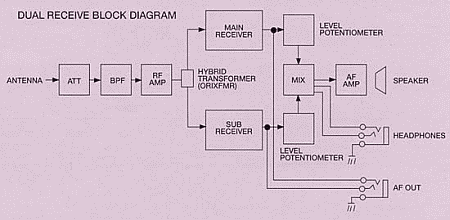
The Sub VFO functions similarly to the main VFO. It is useful for monitoring a different frequency and is also used for SPLIT. Settings from the main VFO (frequency, mode, filtering) can be transferred to the Sub VFO. The second RX, tuned by this VFO, operates as a superhet with two intermediate frequencies, while the main RX has three. The output audio signals can be mixed, or when using stereo headphones, listened to separately – the main RX with the left headphone and the second RX with the right!
The transceiver has 99 memories, which can be divided into five groups. The memory stores the frequency, mode, and filtering. Working with memories is convenient, with options for moving, copying, tuning memories, and much more... Additionally, there are 5 memories designated as Quick Memory Bank, suitable for temporary recordings without overwriting regular memories. Memory scanning, Programmed Memory Scanning, uses 9 more special memories for this purpose.
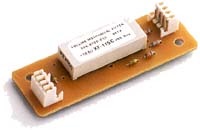
Digital Signal Processing (DSP) is applied at the third intermediate frequency at a frequency of 10.24 kHz. It uses a 16-bit NEC processor operating at a clock speed of 33 MHz. The setting of the EDSP bandwidth is possible in several variants. Very effective is autonotch, which is very fast because the EDSP circuits constantly analyze the components of the audio output and immediately eliminate any interfering signal when detected. SHIFT and WIDTH also work reliably. Noise reduction works satisfactorily, although not excellently. However, two noise blankers work well overall.For QRM suppression, the FT-1000MP is equipped very well.
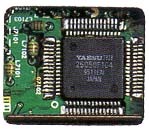

CW operation is very simple. Just connect a mechanical key or paddle. The built-in electronic key offers two iambic modes, variable weighting, ACS (automatic character spacing), semi and full break-in (QSK). All parameters and timings are adjustable in the menu. After connecting the external FH-1 controller, you can also use 6 memories for calling and more.
Narrowband FM operation at 28 MHz is also possible with the FT-1000MP. Low-level 88.5 Hz tone and standard 100 kHz offset are used for working through transceivers. This parameter can also be changed in the menu.

Automatický ATU je štandardnou súčasťou FT-1000MP. Dokáže Customize anténu s impedanciou od 20 po 150 ohm. ATU má 39 pamätí, čo umožňuje rýchle naladenie bežne používanej antény.
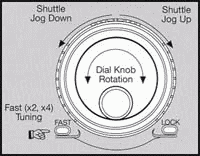 For receiving AM radio stations, a synchro detector can be activated. This is used for signals from long distances, which undergo various phase distortions. In this case, the RX switches to LSB and the carrier frequency is complemented. Alternatively, quality reception can be achieved by listening on headphones with precise tuning of the main RX to LSB and sub RX to USB.
For receiving AM radio stations, a synchro detector can be activated. This is used for signals from long distances, which undergo various phase distortions. In this case, the RX switches to LSB and the carrier frequency is complemented. Alternatively, quality reception can be achieved by listening on headphones with precise tuning of the main RX to LSB and sub RX to USB.
The internal design of the transceiver is very clean. After removing the top cover, there is not much to see. On the right front is the speaker, behind it are the input circuits. The left side is filled with the final stage heatsink. When viewed from below, the most noticeable are the intermediate frequency filters. Connections between the PCBs are made with cable bundles terminated with connectors and flat cables. It is also positive that several circuits are in shielding boxes.

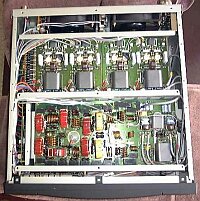
Among other accessories, there are, of course, microphones. Yaesu manufactures two suitable types of desk microphones, MD-100 and MD-200. Also recommended is the SP-8 speaker box. The FTV-1000 is transverter for 6m. The selection of filters is also rich, and they are produced by various manufacturers. Yaesu offers the following: 8.215 MHz filters YF-114SN 2.0 kHz SSB filter, YF-114CN 250 Hz CW filter, and at 455 kHz: YF-110SN 2.0 kHz SSB filter, YF-110CN 250 Hz CW filter, YF-115C 500 Hz Collins mechanical CW filter (for the second RX). To increase stability, you can purchase TCXO-4 or TCXO-6. An interesting addition will be the DVS-2, which is a digital memory for, for example, calling a CQ.
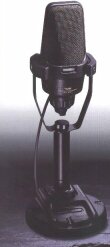
Transceiver comes with a handheld microphone and a 104-page manual. A transceiver of this caliber and complexity needs a good and clear manual, and this one definitely did not disappoint.
 | 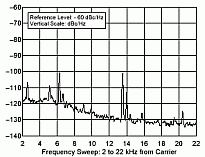 |
Za niekoľko mesiacov prevádzky a porovnávania s IC-751 je možné zistiť, ako za šestnásť rokov vývoj pokročil. Pritom IC-751 nie je slabý tranceiver, ale FT-1000MP sa skrátka nemôže rovnať. Príjem je veľmi čistý a autonotch je skutočne skvelý. Kvalita vysielaného audia aj s ručným mikrofónom je výborná. Pri nastavovaní rečového procesora je potrebná trpezlivosť, ale nie je to nič zložité. Funkcia MONITOR totiž detekuje signál na 455 kHz, nie z koncového stupňa. Takto sa môže sťať, že Final stage tranceivra prebudíme, aj keď na audiu to nie je poznať. Môžem povedať, že Sako Hagesawa JA1MP by bol na svojich technikov hrdý a mal by určite radosť.
